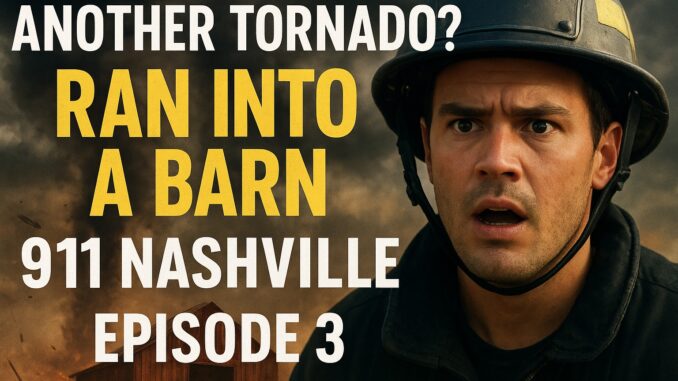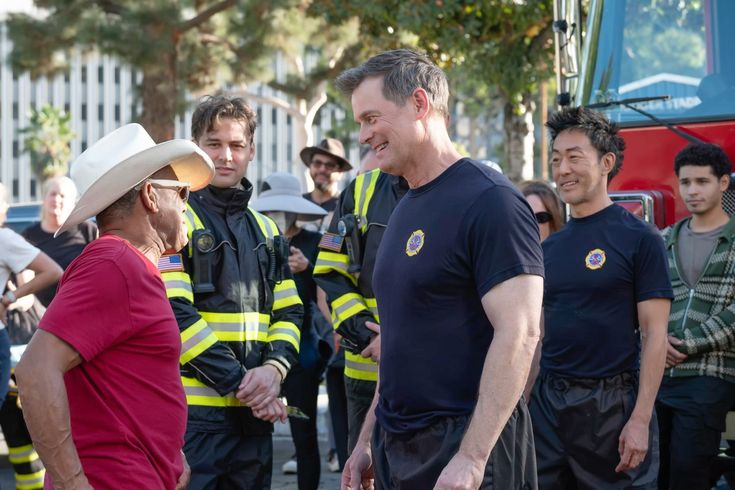
If you’re watching 9‑1‑1: Nashville and scratching your head at the scene in Episode 3 where the team “runs into a barn” as a tornado approaches, you’re not alone. This moment has triggered a wave of bewildered reactions among fans—and for good reason. Tornado protocol, physics, logic… it all seems to go out the window. In this article, we’ll dig into what happened, why it doesn’t make sense, what real tornado preparedness looks like, and what this scene reveals about how disaster-drama works (and sometimes doesn’t).
The Moment That Sparked the Outrage
In Episode 3 of 911 Nashville, the heroes face not just one tornado but “another tornado or two.” Amid the chaos, the dramatic beat lands when our protagonists run into a barn. Quick cut, suspense builds—yet fans immediately balked. It’s a striking narrative choice—but one that clashes with both real-world logic and common sense.
Why Fans Reacted – The Tornado vs Barn Conundrum
It’s Against the Rules of Tornado Safety
If you’ve ever seen classic tornado films like Twister (yes, that one), you know: running into a barn when a tornado is closing in is a textbook don’t. Barns are large, mostly open-air, poorly sheltered. They collapse. They’re dangerous. So when our characters do it, alarm bells ring.
It’s Too Convenient (Narrative vs Reality)
Drama often bends reality to heighten stakes. That’s fine—until it breaks immersion. The “barn run” reads like a plot device rather than a believable emergency response. Fans saw that and thought: did no one watch Twister? Did no one Google “tornado safety”? The disbelief starts there.
The “Another Tornado or Two” Escalation
The episode piles on disaster: multiple tornadoes, intense rescues, barn infiltration—it’s adrenaline overload. But when each escalation removes more realism, the emotional impact dips and the absurdity rises. The line between thrilling and ridiculous gets fuzzy.
What the Show Got Right (Even Amid the Barn Scene)
Strong Visuals & Disaster Spectacle
Despite the logic slip, the show delivers big visuals: swirling winds, collapsing structures, rescue teams under siege. This spectacle is part of the draw. According to previews, a water-tower rescue and tornado path set the tone for the series.
Emotional Stakes & Character Arcs
In disaster dramas, characters make the difference. Even while fans critique the realism, the tension around the station team, the personal lives of the characters, and their bravery still land. These human elements keep viewers engaged beyond the specifics of tornado logic.
The Reality of Tornado Safety – Because Yes, It Matters
Find Shelter Early
When tornado warnings hit, you don’t wait until the twister is on top of you—and running into a barn doesn’t qualify as safe. The recommended approach: head to a basement, interior room, or a purpose-built storm shelter.
Barns Are Not Designed for Tornadoes
Unlike reinforced shelters or interior rooms, barns are often wooden, open, and lacking structural integrity under extreme wind. It’s no surprise survival statistics don’t favor barn-invasion strategies.
Multiple Tornadoes Mean Higher Chaos
When meteorologists warn “another tornado or two,” you’re in serious hazard territory. Plans must be robust. One tornado is bad enough—two or more compound the risk. The show acknowledges that via its chaos, but then undermines it via the barn scene.
Why Writers Might Have Chosen the Barn Scene Anyway
Visual Symbolism and Tension
Barns evoke rural vulnerability: wood, open haylofts, farm equipment, dizzying spaces. From a cinematic standpoint, it offers visual drama. A tornado wrapping around a barn yields strong images.
Character Isolation and Stakes
Putting characters inside a barn gives a claustrophobic edge—even if it’s illogical. It isolates them from the safety of the station, magnifies danger, heightens tension. That’s Hollywood.
Pace and Narrative Flow Over Accuracy
Sometimes realism takes a back seat to pacing. The writers might have felt that “run into a barn” beats “go to basement,” because it’s more unpredictable, more cinematic, more “TV.” But that choice comes at the cost of believability.
Fan Reactions & Viewer Commentary
Social Media Outcry
On forums and social media, many viewers were blunt:
“First episode was rough. Second episode was getting better. Hopefully by the time they get done with this stupid tornado arch everything will …”
One commenter noted:
“We’ve had reports of tornadoes across town. This could be a once in …”
The barn-scene became shorthand for suspension of disbelief being tested.
Reviewing the Franchise
When critics preview the show, they highlight the spectacle:
“A firenado – a rapidly rotating tornado above an intense fire – sends embers torpedoing over Broadway.”
Yet that same review tone wonders: when spectacle grows, does logic shrink?
How This Fits Into the Broader Disaster-Drama Genre
Disaster Movies vs Reality
In many disaster films, logic is stretched: earthquakes that split cities in two, meteors that zip to Earth, etc. Tornadoes hitting barns? That’s not new. But when a TV episode couches it as high-stakes rescue, the mismatch is sharper.
Stakes Need to Feel Real to Connect
Viewers accept dramatic license if it still feels “real enough.” When the gap becomes too wide—barn instead of shelter—the emotional connection frays. The stakes feel cartoonish rather than visceral.
Franchise Expectations
This is part of the larger 9‑1‑1 universe, via 9-1-1: Lone Star and now 9-1-1: Nashville. That universe plays on high stakes, catastrophe, heroism. So bending some realism may be accepted—but there’s a threshold.
What Could Have Been Better (In Terms of Realism)
Use Interior Shelter Instead of Barn
If the characters had sought a small interior room or basement, the tension could still exist (will the roof hold? will the windows blow?) but it would preserve realism.
Acknowledging Mistake
Have a character question the decision: “Are we really going into the barn?” That moment of doubt would let viewers in, connect emotionally, and preserve internal consistency.
Use Tornado Logic for Drama, Not Ignoring It
Instead of ignoring tornado protocols, the show could incorporate them: warning sirens, evacuation, chaos—but balanced with logical choices. That tension between “what must we do?” and “the structure fails anyway” is emotionally stronger.
Why It Matters Even If It’s Fiction
Fiction Influences Perception
People absorb what they see—even in dramatized form. If a show depicts reckless behaviour as heroic, some may internalize it. So when a barn becomes a “safe spot,” the messaging is off.
Credibility Builds Engagement
As a viewer, your belief in the story matters. If you believe the characters, you care about them. When you don’t, you switch off. That barn moment may risk disengagement.
Respecting Real-World Heroes
The emergency responders in the show mirror real professionals. If the script gives them obviously poor choices, it undercuts the honour of those real heroes. The show has to balance drama with respect for the job.

Your Take – What Would You Do?
Have you ever been in a severe weather situation? Maybe not a tornado—but any scenario where you have to act fast and wisely. When seconds matter, decisions matter. Running into a barn? Probably not on your list. Head to a sturdy, interior room instead.
Final Thoughts on Episode 3 and the Barn Scene
Yes, 911 Nashville Episode 3 delivers the big spectacle fans expect. Tornadoes spinning, rescues at the edge, the 113 crew in trouble. But the barn scene? It’s a decision that raises eyebrows. It might work for the drama, but it strains logic. The bigger question: will the show decide to lean back into realism, or keep bending rules in favor of spectacle?
Conclusion
In the world of disaster-TV, we crave adrenaline, high stakes, intense rescues—and 911 Nashville gives that. But when you toss logic out the window (barn invasions in the face of tornadoes?), the ride gets shaky. To keep me and you invested, the show needs to respect the rules of disaster just enough so the characters feel like they’re fighting for their lives—and not just running toward the camera. If they can strike that balance, the series will soar. Until then, I’ll be watching—and questioning every barn they run into.
